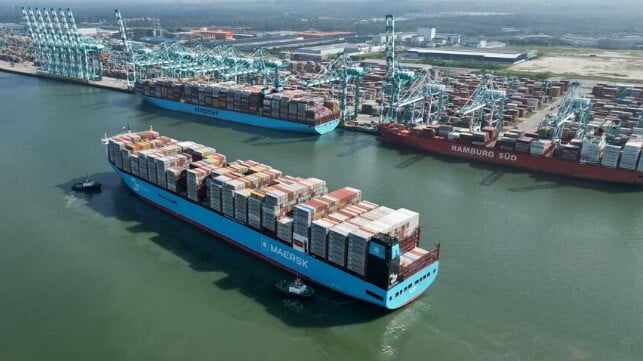Maersk Surprises with Improved Outlook Despite Volatile Environmenment

Maersk, the largest publicly-traded shipping and logistics company and long considered a bellwether for the global economy, surprised with a stronger-than-expected second quarter financial report and outlook. The company believes shippers have been able to adjust, or are still waiting, in the face of a “volatile external environment” created by the uncertainties and tariff threats, leading the company to raise its forecast for 2025.
“We have had a strong first half of the year, driven by consistent follow-through on our operational improvement plans and the successful launch of the Gemini Cooperation,” said Vincent Clerc, CEO of Maersk. “Even with market volatility and historical uncertainty in global trade, demand remained resilient, and we’ve continued to respond with speed and flexibility.”
Maersk reported a better-than-expected 4.2 percent year-over-year increase in volume, which it said was driven mostly by exports out of Asia. The U.S. tariffs have created “significant volatility,” the company said, but it reported that the decline in U.S. imports was more than offset by growth in other regions. This strength, it said, also factored into rates which were “picking up in the quarter, while still being under pressure both sequentially and compared to the previous year.”
The company cited a strong quarter in its terminal operations, APM Terminals reporting record-high volume and revenues for the operation. Logistics and Services, Clerc said, is focused on operational efficiency and delivering sustainable profitability. As a result, the company reported an overall 2.8 percent growth in revenues ($13.1 billion with $8.5 billion from its Ocean segment), and while earnings (EBIT) were down sequentially, the company reported a strong $845 million profit, “despite significant geopolitical uncertainty and continued rate pressure.”
One contributor that Clerc singled out was the launch of the new Gemini Cooperation with Hapag-Lloyd, which completed its phase-in during June. He pointed to schedule reliability above the 90 percent target in the first few months of operation and credited it with adding volumes to the company’s terminal operations.
“Our new East-West network is raising the bar on reliability and setting new industry standards,” said Clerc. “It has been a key driver of increased volumes and solid delivery of our Ocean business.”
Maersk had previously forecast a difficult year for the industry with declines in global volumes. It warned that the disruption in the Red Sea is still expected to last for the full year, but also raised its forecast for global container market volume growth of between 2 and 4 percent after previously saying the segment’s volume could be down by as much as 1 percent.
“Given the more resilient market demand outside of North America, Maersk raised its full-year 2025 financial guidance,” the company reported. While still expecting a challenging second half of the year, the company is now forecasting profits (EBIT) of between $2 and $3.5 billion, up from a forecast that set the low end of 2025 at breakeven.
While most major stock market indexes were down today, the first day that Donald Trump’s reciprocal tariffs started for many countries, the price of Maersk’s shares finished the day up more than 5 percent. The strong report also raised hopes for the shipping sector's ability to navigate through the uncertainties after Vincent Clerc told investors he believes container shipping is “immune” to trade tariffs in the short term.
